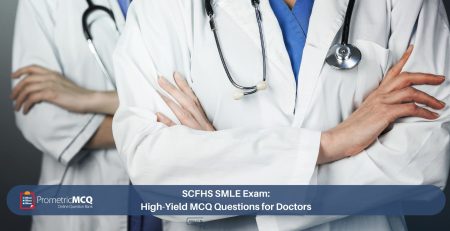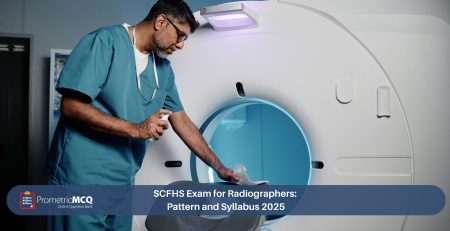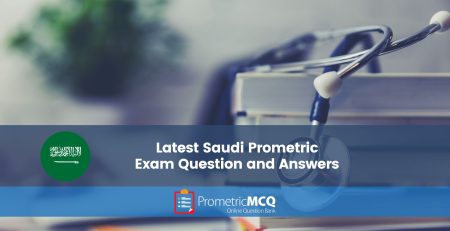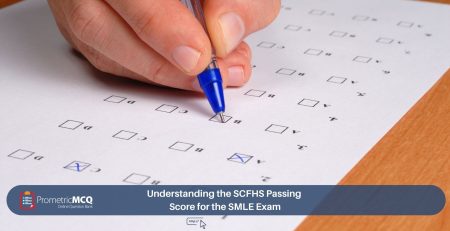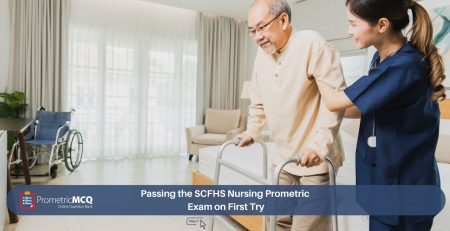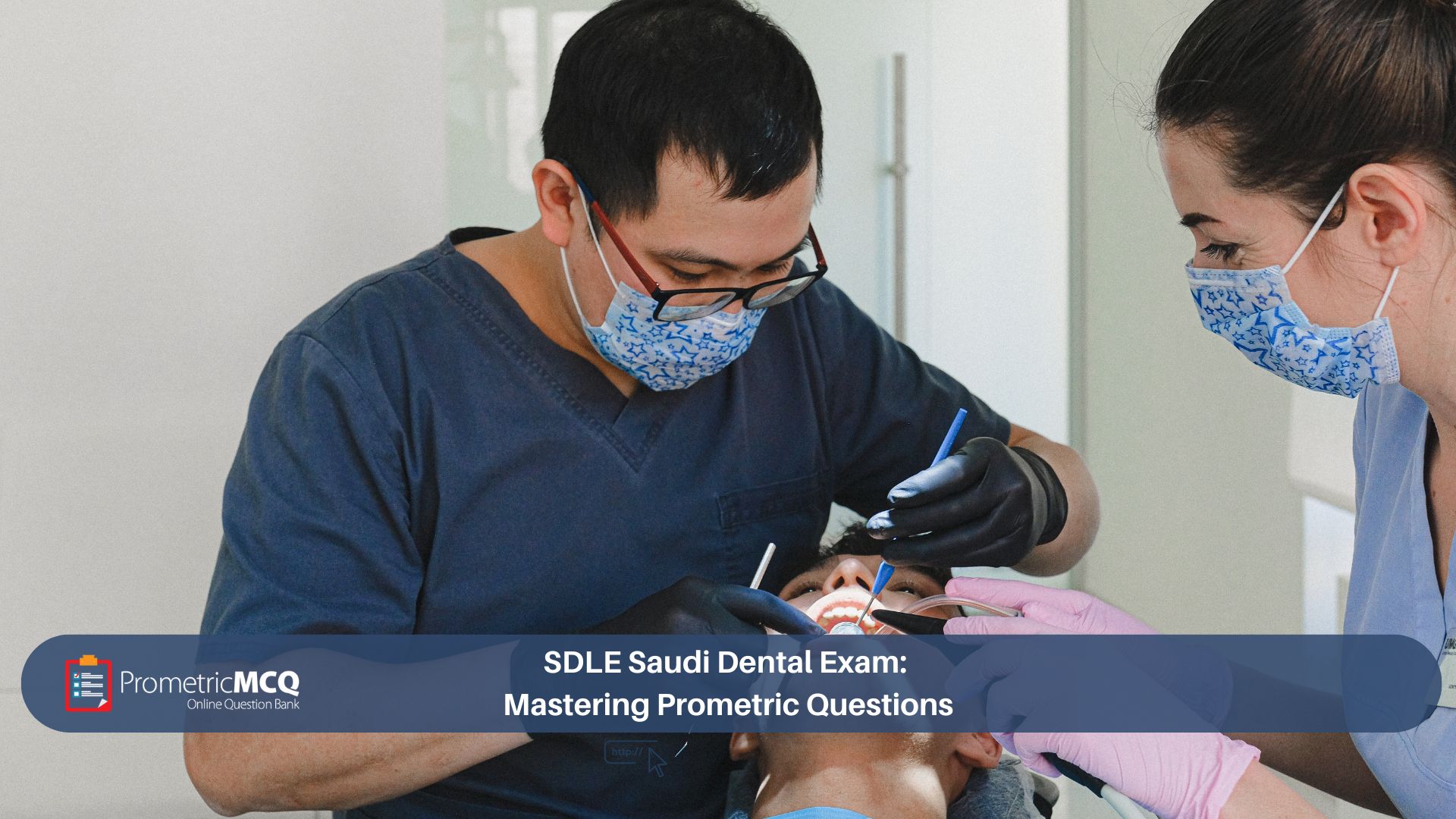
SDLE Saudi Dental Exam: Mastering Prometric Questions
fatima@prometricmcq.com2025-09-17T15:51:42+00:00Table of Contents
ToggleSDLE Saudi Dental Exam: Mastering Prometric Questions
The Saudi Dental Licensing Exam (SDLE) is the critical threshold every dentist must cross to practice in the Kingdom of Saudi Arabia. Administered by the Saudi Commission for Health Specialties (SCFHS), this Prometric exam is globally respected for its clinical rigor. However, many accomplished clinicians find the exam challenging not because they lack dental knowledge, but because they haven’t mastered the art of deconstructing and answering its specific style of Multiple-Choice Questions (MCQs).
Passing the SDLE is a science. It requires more than just knowing the facts; it demands the ability to quickly analyze a clinical vignette, identify the core question being asked, eliminate plausible but incorrect distractors, and select the single best answer under significant time pressure. This skill—the mastery of the Prometric question format—is what separates a passing candidate from a failing one. It is a skill that must be deliberately cultivated through strategic practice.
This ultimate 2025 guide is laser-focused on that singular goal: to teach you how to master the SDLE questions. We will move beyond a simple syllabus review and dive deep into the methodology of the exam itself. You will learn to think like a test maker, analyze the anatomy of an SDLE question, and apply proven strategies to navigate even the most complex clinical scenarios. Packed with in-depth sample questions and a 10-point FAQ, this guide is your key to transforming your preparation from passive learning into an active, question-driven strategy for success on the Prometric dental licensing exam.
Key Takeaways for Mastering SDLE Questions
- Think ‘Why,’ Not Just ‘What’: The best answer is often based on the underlying principle. Understand the rationale behind a treatment, not just the treatment itself.
- Deconstruct the Vignette: Every word in the clinical scenario matters. Learn to quickly identify the patient’s age, chief complaint, relevant medical history, and key clinical/radiographic findings.
- Master the Art of Elimination: You can often find the correct answer by confidently eliminating the three incorrect ones. Learn to spot distractors based on absolute terms or outdated practices.
- Time Management is a Skill: With an average of 72 seconds per question, pacing is critical. Practice with timed mock exams to build speed and accuracy.
- A QBank is Your Best Sparring Partner: There is no substitute for practicing with thousands of high-quality, exam-style MCQs. It’s the only way to build the necessary mental stamina and pattern recognition.
The Anatomy of an SDLE Prometric Question
To master the questions, you must first understand their structure. Nearly every question on the SDLE is a clinical vignette designed to test application, not just recall. They typically have three components:
- The Case Presentation (Stem): This is the clinical scenario. It introduces the patient, their history, and the clinical problem. It might include signs, symptoms, and radiographic findings.
- The Lead-In Question: This is the specific question being asked (e.g., “What is the most likely diagnosis?”, “What is the most appropriate next step?”).
- The Options (A, B, C, D): This includes one single best answer (the key) and three distractors. Distractors are cleverly designed to be plausible but ultimately incorrect.
Your first task when reading a question is to ignore the options. Read the stem and the lead-in question, and try to formulate the answer in your own mind. This prevents you from being swayed by attractive-looking distractors.
Strategic Approaches to Answering SDLE MCQs
Adopting a systematic approach for every question will dramatically improve your accuracy and efficiency. This is a core part of effective SCFHS exam preparation.
1. The Keyword Scanning Technique
As you read the stem, train your brain to highlight keywords. These are the critical data points that will lead you to the correct diagnosis or treatment.
- Patient Demographics: Age and gender can be clues (e.g., a young child with primary teeth vs. an elderly patient with root caries).
- Medical History: Look for key conditions like diabetes, hypertension, or use of medications like bisphosphonates or anticoagulants.
- Descriptive Words: Pay attention to adjectives like “severe,” “spontaneous,” “throbbing,” “dull,” “localized,” or “diffuse.” They are crucial for differential diagnosis.
- Radiographic Findings: “Well-defined radiolucency,” “widened PDL,” “loss of lamina dura,” or “sunburst appearance” are all classic descriptors for specific pathologies.
2. The Process of Elimination (PoE)
This is your most powerful tool. Even if you are unsure of the correct answer, you can often identify options that are clearly incorrect. Look for:
- Absolute Terms: Options that use words like “always,” “never,” or “all” are often incorrect, as there are few absolutes in medicine and dentistry.
- Outdated Concepts: The exam tests current, evidence-based dentistry. Be wary of options that describe historical or obsolete techniques.
- Irrelevant Options: Sometimes, an option may be a correct statement but is not relevant to the specific question being asked.
In-Depth SDLE Sample Questions & Strategic Breakdown
Let’s apply these strategies to realistic SDLE questions. We will not only provide the rationale for the correct answer but also deconstruct why the distractors are wrong.
Question 1: Prosthodontics & Treatment Planning
An 80-year-old edentulous patient with severely resorbed mandibular ridges complains that his lower denture “floats” and has poor stability. He is medically fit but has limited financial resources. Which of the following treatment options would provide the MOST significant improvement in stability for his mandibular denture?
- Performing a vestibuloplasty and fabricating a new conventional denture.
- Placing two standard-diameter implants in the canine regions for an implant-retained overdenture.
- Using a permanent soft liner in the existing denture.
- Fabricating a new denture with a wider buccal shelf and lingual flange extension.
Correct Answer: B
Strategic Breakdown: The keyword here is “MOST significant improvement in stability.” The patient’s chief complaint is a “floating” denture due to “severely resorbed ridges.” This indicates a complete lack of anatomical retention. While other options might offer minor improvements, only implants provide a definitive mechanical solution for retention and stability.
Rationale: According to the McGill consensus statement on overdentures, the standard of care for a fully edentulous mandible is a two-implant overdenture. This option directly addresses the core problem of a lack of retention in a severely atrophic ridge by providing mechanical anchorage, which dramatically improves stability, function, and patient satisfaction.
Why other options are incorrect:
A: A vestibuloplasty deepens the sulcus to increase the flange height. While it can improve peripheral seal and stability, it is a surgically invasive procedure and its success is limited in cases of severe resorption. It would not provide as significant an improvement as implants.
C: A permanent soft liner is used to improve comfort over a sharp, bony ridge or to engage undercuts for retention. It does little to improve the overall stability of a denture on a flat, resorbed ridge.
D: While fabricating a new denture with optimal extension is a fundamental principle, its effectiveness is severely limited by the anatomy. On a severely resorbed ridge, there is simply not enough anatomy for even a perfectly made conventional denture to be stable. It would be an improvement, but not the *most significant* one.
Question 2: Periodontics & Diagnosis
A 30-year-old male patient, who is a heavy smoker (20 cigarettes/day), presents with generalized gingival pain, bleeding, and a fetid odor. Clinical examination reveals blunted, “punched-out” interdental papillae covered by a grayish pseudomembrane. What is the most likely diagnosis?
- Chronic Periodontitis
- Aggressive Periodontitis
- Necrotizing Ulcerative Gingivitis (NUG)
- Herpetic Gingivostomatitis
Correct Answer: C
Strategic Breakdown: This is a classic pattern recognition question. The keywords are “punched-out papillae,” “grayish pseudomembrane,” “fetid odor,” and “heavy smoker.” This constellation of signs and symptoms is pathognomonic for NUG.
Rationale: Necrotizing Ulcerative Gingivitis (NUG) is an acute infection of the gingiva characterized by the triad of pain, interdental necrosis (punched-out papillae), and bleeding. The presence of a grayish pseudomembrane and a distinct malodor are also hallmark features. Smoking and stress are major predisposing factors.
Why other options are incorrect:
A: Chronic periodontitis is a slow-progressing disease characterized by attachment loss and bone loss, but not the acute, painful, necrotic presentation of NUG.
B: Aggressive periodontitis is characterized by rapid attachment and bone loss in otherwise healthy individuals, typically affecting incisors and first molars, but it lacks the ulcerative and pseudomembranous features.
D: Primary herpetic gingivostomatitis presents with fever, malaise, and widespread vesicular eruptions on the gingiva and oral mucosa, which then rupture to form ulcers. It does not cause the specific “punched-out” necrosis of the papillae.
Frequently Asked Questions (FAQs) for the SDLE
The single most effective strategy is consistent, high-volume practice with a reputable, specialized QBank. The goal is not just to answer questions, but to deeply understand the rationale behind every correct and incorrect option. This active learning process builds the clinical reasoning and pattern recognition skills essential for the exam.
The SDLE consists of two 100-question sections, each with a two-hour time limit (120 minutes). This gives you 1.2 minutes (72 seconds) per question. A good strategy is to aim to answer each question in about 60 seconds. This builds a 20-minute buffer at the end of each section to review any questions you marked as difficult.
First, use the process of elimination to discard any obviously incorrect options. Then, re-read the lead-in question to ensure you understand what is being asked. If you are still stuck between two options, make an educated guess based on fundamental principles (e.g., choose the most conservative option, or the one that prioritizes patient safety). Since there is no negative marking, never leave a question unanswered.
Yes, you can expect a significant number of questions that include attachments like periapical radiographs, bitewings, panoramic X-rays, or clinical photos of oral lesions. Your ability to interpret these images is a core competency being tested. Therefore, your preparation must include practicing with these types of questions.
The SDLE tests established, evidence-based dentistry, not cutting-edge or experimental techniques. Focus on mastering the properties and applications of mainstream materials (composites, ceramics, impression materials) and technologies. You can stay updated by reviewing recent guidelines from major international bodies like the FDI World Dental Federation.
For common dental drugs, yes. You should know the standard dosages for common analgesics (e.g., ibuprofen, paracetamol), antibiotics used for dental infections (e.g., amoxicillin, metronidazole), and the maximum recommended doses for local anesthetics. Questions related to dosages are common as they are directly related to patient safety.
This means that more than one option may seem correct or plausible. Your task is to identify the *most* correct, most appropriate, or most important answer among the choices. This requires a higher level of clinical judgment than simple recall questions.
Passing the SDLE makes you eligible for professional registration with the SCFHS, pending the completion of your DataFlow PSV. Once both are complete, you will be classified and can secure a job offer. Your employer will then help you activate your license. This entire journey is what leads to your final SCFHS license.
Yes, indirectly. High-quality, case-based MCQs force you to constantly engage in differential diagnosis and treatment planning. This repeated mental exercise strengthens the clinical reasoning pathways that you use in real-world practice, making you a more thoughtful and evidence-based clinician.
It is crucial to use a source that specializes in the Saudi Prometric exams. Generic dental MCQs may not reflect the specific style and emphasis of the SDLE. A dedicated platform like PrometricMCQ offers a large bank of SDLE-specific questions designed to accurately simulate the real exam experience.
Conclusion: From Knowledge to Mastery
The SDLE is not a test of what you know, but how you think. By shifting your preparation from passive reading to active problem-solving with MCQs, you build the critical skills needed to succeed. Deconstruct every question, understand every rationale, and practice relentlessly under timed conditions. This strategic, question-centric approach will not only prepare you to pass the exam but will also make you a more confident and competent clinician, ready for a successful career in Saudi Arabia.
Stop Memorizing. Start Analyzing. Master the SDLE.
Gain the ultimate advantage with our premium QBank, featuring thousands of realistic SDLE clinical vignettes, exhaustive rationales, and timed mock exams that replicate the Prometric experience.


